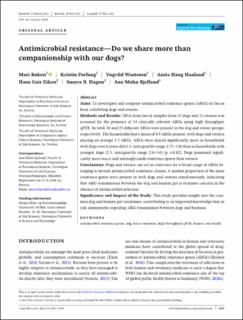| dc.contributor.author | Røken, Mari | |
| dc.contributor.author | Forfang, Kristin | |
| dc.contributor.author | Wasteson, Yngvild | |
| dc.contributor.author | Haaland, Anita Haug | |
| dc.contributor.author | Eiken, Hans Geir | |
| dc.contributor.author | Hagen, Snorre | |
| dc.contributor.author | Bjelland, Ane Mohn | |
| dc.date.accessioned | 2022-10-11T08:21:50Z | |
| dc.date.available | 2022-10-11T08:21:50Z | |
| dc.date.created | 2022-08-08T14:02:41Z | |
| dc.date.issued | 2022-05-21 | |
| dc.identifier.citation | Journal of Applied Microbiology. 2022, 133 (2), 1027-1039. | en_US |
| dc.identifier.issn | 1364-5072 | |
| dc.identifier.uri | https://hdl.handle.net/11250/3025293 | |
| dc.description.abstract | Aims To investigate and compare antimicrobial resistance genes (ARGs) in faeces from cohabiting dogs and owners. Methods and Results DNA from faecal samples from 35 dogs and 35 owners was screened for the presence of 34 clinically relevant ARGs using high throughput qPCR. In total, 24 and 25 different ARGs were present in the dog and owner groups, respectively. The households had a mean of 9.9 ARGs present, with dogs and owners sharing on average 3.3 ARGs. ARGs were shared significantly more in households with dogs over 6 years old (3.5, interquartile range 2.75–5.0) than in households with younger dogs (2.5, interquartile range 2.0–3.0) (p = 0.02). Dogs possessed significantly more mecA and aminoglycoside resistance genes than owners. Conclusions Dogs and owners can act as reservoirs for a broad range of ARGs belonging to several antimicrobial resistance classes. A modest proportion of the same resistance genes were present in both dogs and owners simultaneously, indicating that ARG transmission between the dog and human gut is of minor concern in the absence of antimicrobial selection. Significance and Impact of the Study This study provides insight into the common dog and human gut resistomes, contributing to an improved knowledge base in risk assessments regarding ARG transmission between dogs and humans. | en_US |
| dc.description.abstract | Antimicrobial resistance—Do we share more than companionship with our dogs? | en_US |
| dc.language.iso | eng | en_US |
| dc.publisher | John Wiley & Sons Ltd on behalf of Society for Applied Microbiology | en_US |
| dc.rights | Navngivelse 4.0 Internasjonal | * |
| dc.rights.uri | http://creativecommons.org/licenses/by/4.0/deed.no | * |
| dc.title | Antimicrobial resistance—Do we share more than companionship with our dogs? | en_US |
| dc.title.alternative | Antimicrobial resistance—Do we share more than companionship with our dogs? | en_US |
| dc.type | Peer reviewed | en_US |
| dc.type | Journal article | en_US |
| dc.description.version | publishedVersion | en_US |
| dc.rights.holder | © 2022 The Authors | en_US |
| dc.source.pagenumber | 1027-1039 | en_US |
| dc.source.volume | 133 | en_US |
| dc.source.journal | Journal of Applied Microbiology | en_US |
| dc.source.issue | 2 | en_US |
| dc.identifier.doi | 10.1111/jam.15629 | |
| dc.identifier.cristin | 2041752 | |
| cristin.ispublished | true | |
| cristin.fulltext | original | |
| cristin.qualitycode | 1 | |

